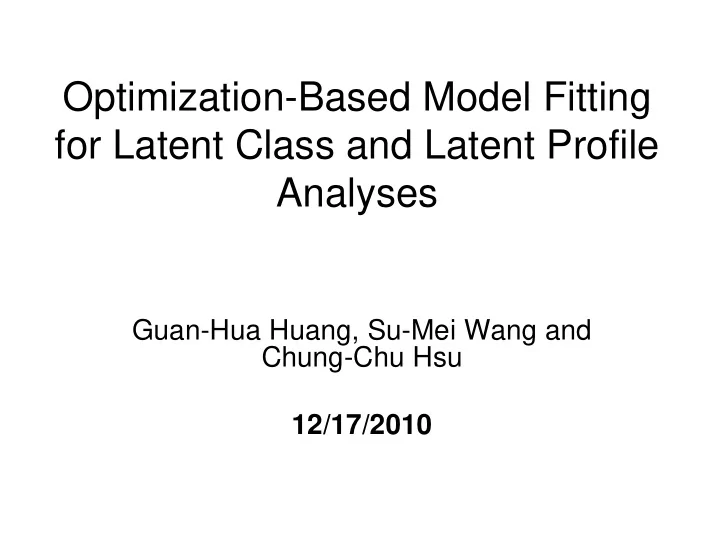

Optimization-Based Model Fitting for Latent Class and Latent Profile Analyses Guan-Hua Huang, Su-Mei Wang and Chung-Chu Hsu 12/17/2010
Breast cancer data van't Veer et al . Nature 2002 The 78 sporadic lymph-node-negative breast cancer patients 44 remained free of disease for an interval of at least 5 years (good prognosis group) 34 had developed distant metastases within 5 years (poor prognosis group). Aim to predict good and poor prognostic patients through gene expression profiling
Breast cancer data (cont’d) A preliminary two-step gene selection process (from 24481 genes): 4741 genes with the intensity ratio more than two-fold difference and the significance of regulation p-value < 0.01 in more than 3 patients Apply a selection of genes based on the ratio of their between-group to within-group sums of squares ( )( ) ∑∑ = − 2 I d c y y ( ) = . i cm m i c BW m ( )( ) ∑∑ = − 2 I d c y y i im cm i c
BW plot 70
Breast cancer data (cont’d) Using 70 selected gene expression ratios as observed surrogates, a finite mixture model was fitted.
Schizophrenia data The data were collected from a series of projects for schizophrenia (Dr. Hai-Gwo Hwu). The analyzed data include 169 acute patients of schizophrenia who were recruited within one week of index admission 160 subsided state patients who were living with community and under family care Aim to explore the subtypes of schizophrenia patients predict patients' phases of chronicity
Schizophrenia data (cont’d) Schizophrenia symptoms were assessed by the PANSS: 30 items and consists of three subscales: positive, negative and general psychopathology Each item was originally rated on a 7-point scale (1=absent, 7=extreme), but we reduced the 7-point scale by merging the points that had the response percentages less than 10%
Models gender, age Gene expression PANSS items environmental variables 8
Introduction Finite mixture model is an analogy of cluster analysis. Finite mixture model classifies objects based on their responses to a set of surrogates. Measured surrogates are assumed independent of one another within any category of the underlying latent variable. Use k-means and hierarchical clustering methods with covariance among surrogates as the distance measure.
Finite mixture model = T ( Y , , Y ) Y : M observable surrogates i 1 i iM J { } ∑ = = = ( , , ) Pr( ) ( , , | ) f y y S j f y y S j 1 1 i iM i i iM i = 1 j J M ∑ ∏ = = = Pr( ) ( | ) S j f y S j i im i = = 1 1 j m
Latent Class Membership Estimation
Background The key is to estimate the latent class membership. Use K-means and hierarchical clustering methods to group the objects such that observed variables are statistically independent within latent classes. Use sample covariance matrix as the independence measurement.
Independence measurement ~ = ( Y , Y , , Y ) Y Supposed i i1 i2 iM Then, cov(Y , Y ) cov(Y , Y ) cov(Y , Y ) i1 i1 i1 i2 i1 iM cov(Y , Y ) cov(Y , Y ) cov(Y , Y ) ~ = i2 i1 i2 i2 i2 iM Cov( ) Y i cov(Y , Y ) cov(Y , Y ) cov(Y , Y ) iM i1 iM i2 iM iM = − − ACov (| in |) mean entries non diagonal block
K-means algorithm K-means => Assign object 1 to the class corresponding to minimum LoI
Agglomerative hierarchical => Merge the pair of classes whose combination results in the minimum LoI
Divisive hierarchical => Split the class whose division results in the minimum LoI
Classification using finite mixture models = For a new object with the * * * ( , , ) Y Y Y 1 M disease status D * { } J ∑ = = = = × = * * * * * * * Pr( | ) Pr( | , ) Pr( | ) D c Y D c S j Y S j Y = 1 j Allocate Y * to D * = c * at which the maximum estimated posterior probability is reached
Cancer data: agglomerative hierarchical
Cancer data: divisive hierarchical
Leave-one-out cross-validation Misclassification rates in predicting poor vs. good prognosis k-means: 24.36% agglomerative hierarchical: 26.92% divisive hierarchical: 29.49%
Additional independent test set Independent 19 young, lymph-node- negative breast cancer patients: 12 poor prognosis 7 good prognosis No. 1 2 3 4 5 6 7 8 9 10 11 12 13 14 15 16 17 18 19 0 0 0 0 0 0 0 0 0 0 0 0 1 1 1 1 1 1 1 True KM 0 0 0 0 0 0 0 0 0 0 0 0 1 0 1 0 1 0 1 AH 0 0 0 1 0 0 0 0 0 0 0 1 1 1 1 1 1 0 1 DH 0 0 0 0 0 0 0 0 0 0 0 0 1 1 1 0 1 0 1
Schizo: agglomer ative hierarchic al
Schizo: divisive hierarchical
Leave-one-out cross-validation Misclassification rates in predicting acute vs. subsided schizophrenia k-means: 23.10% agglomerative hierarchical: 24.01% divisive hierarchical: 28.27%
Recommend
More recommend